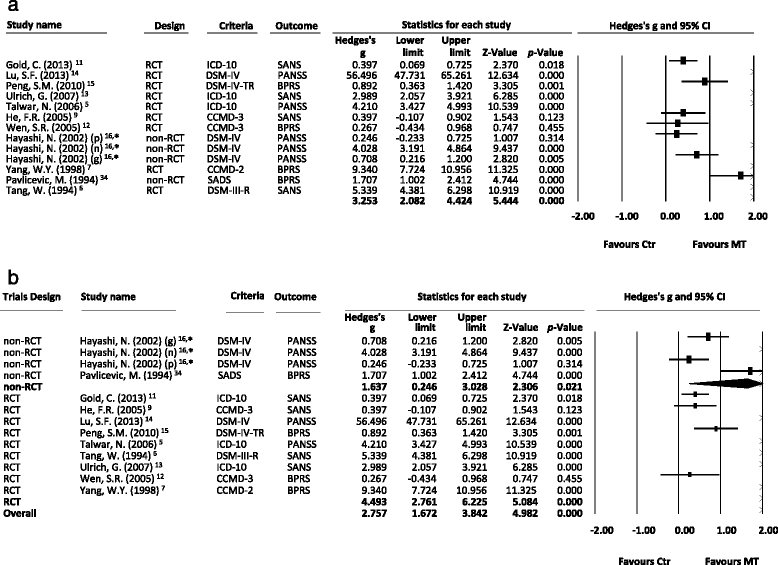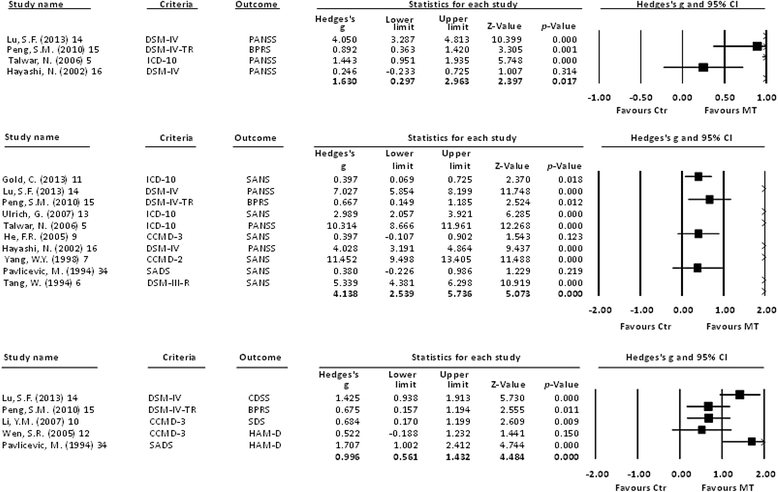Significant treatment effect of adjunct music therapy to standard treatment on the positive, negative, and mood symptoms of schizophrenic patients: a meta-analysis
- PMID: 26812906
- PMCID: PMC4728768
- DOI: 10.1186/s12888-016-0718-8
Significant treatment effect of adjunct music therapy to standard treatment on the positive, negative, and mood symptoms of schizophrenic patients: a meta-analysis
Erratum in
-
Erratum to: Significant treatment effect of adjunct music therapy to standard treatment on the positive, negative, and mood symptoms of schizophrenic patients: a meta-analysis.BMC Psychiatry. 2016 May 17;16:150. doi: 10.1186/s12888-016-0846-1. BMC Psychiatry. 2016. PMID: 27188423 Free PMC article. No abstract available.
Abstract
Background: Music therapy (MT) has been used as adjunct therapy for schizophrenia for decades. However, its role is still inconclusive. A recent meta-analysis demonstrated that MT for schizophrenic patients only significantly benefits negative symptoms and mood symptoms rather than positive symptoms. In addition, the association between specific characteristics of MT and the treatment effect remains unclear. The aim of this study was to update the published data and to explore the role of music therapy in adjunct treatment in schizophrenia with a thorough meta-analysis.
Methods: We compared the treatment effect in schizophrenic patients with standard treatment who did and did not receive adjunct MT through a meta-analysis, and investigated the clinical characteristics of MT through meta-regression.
Results: The main finding was that the treatment effect was significantly better in the patients who received adjunct MT than in those who did not, in negative symptoms, mood symptoms, and also positive symptoms (all p < 0.05). This significance did not change after dividing the patients into subgroups of different total duration of MT, amounts of sessions, or frequency of MT. Besides, the treatment effect on the general symptoms was significantly positively associated with the whole duration of illness, indicating that MT would be beneficial for schizophrenic patients with a chronic course.
Conclusions: Our meta-analysis highlights a significantly better treatment effect in schizophrenic patients who received MT than in those who did not, especially in those with a chronic course, regardless of the duration, frequency, or amounts of sessions of MT. These findings provide evidence that clinicians should apply MT for schizophrenic patients to alleviate disease severity.
Figures



Similar articles
-
The effectiveness of adjunct music therapy for patients with schizophrenia: A meta-analysis.Psychiatry Res. 2020 Nov;293:113464. doi: 10.1016/j.psychres.2020.113464. Epub 2020 Sep 19. Psychiatry Res. 2020. PMID: 33002835 Review.
-
[Maintenance electroconvulsive therapy and treatment of refractory schizophrenia].Encephale. 2008 Oct;34(5):526-33. doi: 10.1016/j.encep.2007.08.008. Epub 2008 Jan 11. Encephale. 2008. PMID: 19068343 French.
-
Effects of music therapy on mood, pain, and satisfaction in the neurologic inpatient setting.Disabil Rehabil. 2023 Sep;45(18):2964-2975. doi: 10.1080/09638288.2022.2117863. Epub 2022 Sep 21. Disabil Rehabil. 2023. PMID: 36129349
-
[Acute schizophrenia concept and definition: investigation of a French psychiatrist population].Encephale. 2005 Jan-Feb;31(1 Pt 1):10-7. doi: 10.1016/s0013-7006(05)82367-x. Encephale. 2005. PMID: 15971635 French.
-
Music therapy as a complementary form of therapy for mental disorders.Pol Merkur Lekarski. 2019 Dec 27;47(282):240-243. Pol Merkur Lekarski. 2019. PMID: 31945027 Review.
Cited by
-
How Music Impacts Visual Attention Training in Schizophrenia: A Pilot Study.J Nerv Ment Dis. 2018 Dec;206(12):968-970. doi: 10.1097/NMD.0000000000000911. J Nerv Ment Dis. 2018. PMID: 30439783 Free PMC article.
-
Nurse-Implemented Music Therapy to Reduce Anxiety in Community-Dwelling Individuals with Severe Mental Illness: A Pilot Study.Nurs Rep. 2024 Mar 22;14(2):695-706. doi: 10.3390/nursrep14020053. Nurs Rep. 2024. PMID: 38525699 Free PMC article.
-
Efficacy of Horticultural Therapy on Positive, Negative, and Affective Symptoms in Individuals with Schizophrenia: A Systematic Review and Meta-Analysis of Randomized Controlled Trials.Healthcare (Basel). 2024 Oct 22;12(21):2104. doi: 10.3390/healthcare12212104. Healthcare (Basel). 2024. PMID: 39517317 Free PMC article. Review.
-
Evidence for music therapy and music medicine in psychiatry: transdiagnostic meta-review of meta-analyses.BJPsych Open. 2024 Dec 13;11(1):e4. doi: 10.1192/bjo.2024.826. BJPsych Open. 2024. PMID: 39668615 Free PMC article. Review.
-
Effect of music listening on P300 event-related potential in patients with schizophrenia: A pilot study.Schizophr Res. 2020 Feb;216:85-96. doi: 10.1016/j.schres.2019.12.026. Epub 2020 Jan 7. Schizophr Res. 2020. PMID: 31924375 Free PMC article.
References
Publication types
MeSH terms
LinkOut - more resources
Full Text Sources
Other Literature Sources
Medical

